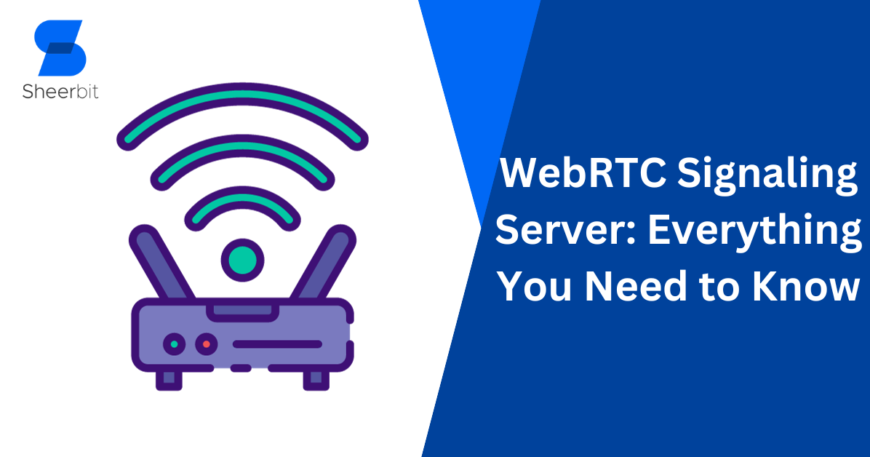WebRTC, or online Real-Time Communication, is a ground-breaking technology that sends data, video, and audio in real-time within mobile apps and online browsers. It has completely changed how we communicate online, making it possible to do anything from share screens to make video conversations to work together to edit documents. Nevertheless, the magic that enables WebRTC depends on a crucial element known as a signalling server; it does not occur spontaneously. In this extensive tutorial, we’ll go further into the world of WebRTC signalling servers, explaining what they are, how they function, and why they are necessary for smooth real-time communication.
What Is WebRTC Signaling?
WebRTC is fundamentally a peer-to-peer communication protocol. When two or more users wish to connect in real-time. They need a method to share device, network address, and media preference information. Herein lies the role of the signalling process.
Devices exchange information and interact with each other via WebRTC signalling, which is required to establish a peer-to-peer connection. It serves as the traffic cop, guiding mobile and online apps in handling different components of the communication session, negotiating media formats, and creating relationships.
Signalling servers are essential to this procedure in the context of WebRTC. They facilitate the discovery and establishment of connections between devices, negotiate network traversal techniques (such as NAT traversal), and set up the basic settings for the communication session.
How WebRTC Signaling Works
Let’s dissect the normal signalling process into a few parts to understand better how WebRTC signalling functions:
- Session Initialization: For two users to communicate, a link must be made between their devices through information transmission. To accomplish this, start a session with information about their network and device setups.
- Offer/Answer Exchange: One device sends an “offer” at this phase, including details about the media it wants to transfer and the preferred settings. In response, the other device provides an “answer” comprising its media settings and preferences. Thanks to this exchange, Both devices can agree on the session settings.
- ICE Candidate Exchange: The method of Interactive Connectivity Establishment (ICE) is essential for handling network traversal problems such as firewall and network address translation (NAT). Every device creates and exchanges a list of ICE candidates or prospective network addresses with the other device. The signalling server is partially in charge of overseeing this exchange.
- Connection Establishment: The devices can establish a direct connection once they have agreed upon the session’s parameters and exchanged ICE candidates. Here, voice, video, and data are sent between the devices to start real-time conversations.
The Role of Signaling Servers
WebRTC signalling revolves around signalling servers, which act as the connecting thread between all the communication components. Here is a closer examination of their primary roles:
- Message Relay: Message relaying between the communicating devices is the responsibility of signalling servers. This entails transmitting offers, responses, ICE candidates, and other crucial signalling information.
- User Presence and Discovery: Signalling servers facilitate device discovery. They save user data, including contact details and information about their whereabouts. The server helps find the intended user and establish the connection when a user wants to start a session.
- Session Management: Communication session establishment and administration are supervised by signalling servers. They ensure setting the proper session configurations and synchronizing all connection participants.
- Error Handling and Recovery: Signalling servers are essential for locating and resolving communication problems that meet faults. They assist gadgets in recovering from mistakes, like lost connections, and reestablishing contact as required.
- Security: By enforcing security measures, signalling servers may ensure that only those with permission can join a communication session. They could also aid in the authentication of people and equipment to stop unwanted access.
Types of Signaling Servers
There are several varieties of WebRTC signalling servers, each suited to particular circumstances and use cases. Among the prevalent kinds are:
- TURN (Traversal Using Relay around NAT) Servers: When NAT or firewall constraints prevent direct peer-to-peer communications, TURN servers are employed. When direct contact between devices is impossible, they serve as mediators, transmitting data between devices.
- STUN (Session Traversal Utilities for NAT) Servers: STUN servers are used to find out a device’s public IP address and port. This information is essential for configuring peer-to-peer connections when devices are behind NAT.
- WebSocket Signaling Servers: These servers create and preserve a long-lasting connection between the signalling server and the clients using WebSocket technology. Applications for real-time communication that demand high interaction and minimal latency will find this very helpful.
- XMPP (Extensible Messaging and Presence Protocol) Servers: An open-standard communication protocol called XMPP is frequently utilized in WebRTC apps for signalling. It enables user identification, presence detection, and real-time communications.
- Custom Signalling Servers: Many applications need signalling servers specially designed to meet their specific needs. The variety of technologies and protocols that can be used to develop the intended application is determined by its particular needs.
WebRTC Signaling Server Implementations
You have a few alternatives if you want to include a signalling server in your WebRTC application. Several widely used signalling server implementations consist of:
- WebSocket-Based Implementations: Building a custom WebSocket signalling server is very easy because multiple WebSocket modules and frameworks are available in different programming languages. Libraries like WebSocket (Python), SignalR (.NET), and Socket.io (Node.js) are commonly used for this.
- TURN/STUN Server Software: It is possible to set up relay and NAT traversal servers using open-source TURN and STUN server implementations, including RFC5766-Turn-Server and Coturn.
- XMPP Servers: Using XMPP-based signalling servers in conjunction with WebRTC might be wise if you want more sophisticated real-time messaging features.
- Third-Party Signaling Services: Consider using third-party signalling services like Twilio, Agora, or PubNub if creating and managing your signalling server seems too difficult. These providers might make integrating WebRTC into your application more accessible by providing hosted signalling options.
Why WebRTC Signaling Servers Are Essential
Applications using real-time communication rely on WebRTC signalling servers as their foundation. Because they make sure that devices can locate one another and communicate, WebRTC is a beneficial technology for developers who want to create dynamic and captivating apps. Here are several explanations for the necessity of signalling servers:
- Cross-Network Communication: Thanks to signalling servers, users may interact without interruption, even when their devices are protected by firewalls or other network address translators (NATs). This guarantees a broad range of scenarios for the use of WebRTC.
- Reliable Session Establishment: Reliable session establishment is made possible via signalling servers, even in network outages or shifting circumstances. This dependability is essential for applications that demand steady and persistent real-time communication.
- Security: A part of the communication process security is signalling servers. They can assist with user and device authentication, ensuring only those with permission can join a session.
- Error Handling and Recovery: Communication errors can be detected and corrected with the help of signalling servers. They offer methods for reestablishing broken connections and reconnecting devices, which improves and strengthens the user experience.
WebRTC Signaling Server Best Practices
It’s critical to adhere to recommended practises while utilizing WebRTC signalling servers. To guarantee the dependability and security of your real-time communication service. Here are some pointers to think about:
- Implement Secure Signaling: To ensure the stability and security of your real-time communication service, you must follow advised procedures while using WebRTC signalling servers. Here are some ideas to consider:
- Scalability: Create a scalable signalling server design. You will need to be able to manage more connections and traffic as your application expands.
- Load Balancing: For better performance, use load balancers to split up incoming signalling requests across several signalling server instances equally.
- Authentication and Authorization: Implement robust user authentication and authorization procedures to guarantee that only users with permission may access your application.
- Error Handling: Construct robust error-handling systems to recover from mistakes and gracefully handle unforeseen circumstances without affecting the user experience.
- Monitoring and Logging: Use logging and monitoring tools to check your signalling servers’ functionality and overall health. This can aid in system optimization and problem diagnosis.
Conclusion
The unsung heroes of real-time communication are WebRTC signalling servers. Which facilitate peer-to-peer connections and make online games, video conferencing, and collaboration tools feasible. Devs and companies wishing to use WebRTC in their apps must comprehend the function and importance of these servers.When you start using WebRTC, remember that the signalling server you choose and the architecture of your application might have a big influence on its security and performance. Users can experience safe and flawless real-time communication using the appropriate signalling system and adhering to best practices.
It’s time to use your newly acquired knowledge about WebRTC signalling servers in real-world scenarios. Feel free to explore the realm of signalling servers. If you’re a developer or company owner trying to include WebRTC into your application and provide your users with incredible real-time communication experiences.
We can help with everything from signalling server implementation to investigating third-party signalling options and basic WebRTC queries. Get in touch with us right now, and together, we can turn your idea into a smooth, dynamic, and captivating reality. Your users may take advantage of WebRTC’s advantages with only one click.





